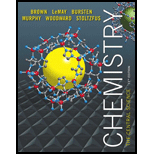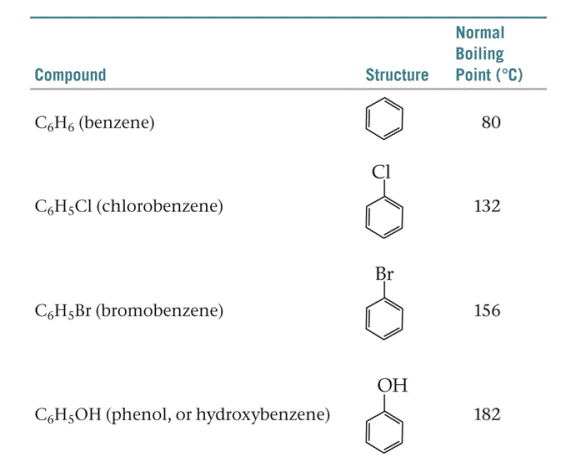
Chemistry: The Central Science (13th Edition)
13th Edition
ISBN: 9780321910417
Author: Theodore E. Brown, H. Eugene LeMay, Bruce E. Bursten, Catherine Murphy, Patrick Woodward, Matthew E. Stoltzfus
Publisher: PEARSON
expand_more
expand_more
format_list_bulleted
Textbook Question
Chapter 2.8, Problem 2.13.2PE
The table below shows the normal boiling points of benzene and benzene derivatives.

- How many of these compounds exhibit dispersion interaction?
- How many of these compounds exhibit dipole-dipole interaction?
- How many of these compounds exhibit hydrogen bonding?
- Why is the boiling point of bromobenzene higher than that of chlorobenzene?
- Why is the boiling point of phenol the highest of all?
Expert Solution & Answer
Want to see the full answer?
Check out a sample textbook solution
Students have asked these similar questions
Using line angle formulas, draw thestructures of and name four alkanes that have total of 7carbons, one of which is tertiary.Please explain this in detail and can you also explain how to approach a similar problem like this as well?
Using dashed line wedge projections drawthe indicated compounds and indicate whether thecompound you have drawn is R or S.(a) The two enantiomers of 2-chlorobutane. Can you please explain your steps and how you would approach a similar problem. Thank you!
5)
There are no lone pairs shown in the structure below. Please add in all lone pairs and then give the
hybridization scheme for the compound. (8)
10,11
7)
1.2.3
H
4
| 14
8)
COC
12
13
H
16
15
H7
9)
-
5.6
C
8
H
10)
H
1).
2)
3)_
11)
12)
13)
4)_
14)
5)
15)
16)
6)
Chapter 2 Solutions
Chemistry: The Central Science (13th Edition)
Ch. 2.3 - Prob. 2.1.1PECh. 2.3 - Prob. 2.1.2PECh. 2.3 - Prob. 2.2.1PECh. 2.3 - Prob. 2.2.2PECh. 2.3 - Prob. 2.3.1PECh. 2.3 - Prob. 2.3.2PECh. 2.4 - Practice Exercise 1 The atomic weight of copper,...Ch. 2.4 - Prob. 2.4.2PECh. 2.5 - Prob. 2.5.1PECh. 2.5 - Prob. 2.5.2PE
Ch. 2.6 - 11.93 The vapor pressure of ethanol (C2H5OH) at 19...Ch. 2.6 - Prob. 2.6.2PECh. 2.7 - Prob. 2.7.1PECh. 2.7 - Prob. 2.7.2PECh. 2.7 - Prob. 2.8.1PECh. 2.7 - Consider the two-dimensional square lattice of...Ch. 2.7 - Prob. 2.9.1PECh. 2.7 - Given the ionic radii and molar masses of Sc3+...Ch. 2.7 - Prob. 2.10.1PECh. 2.7 - Prob. 2.10.2PECh. 2.8 - Prob. 2.11.1PECh. 2.8 - Prob. 2.11.2PECh. 2.8 - Prob. 2.12.1PECh. 2.8 - Prob. 2.12.2PECh. 2.8 - Prob. 2.13.1PECh. 2.8 - The table below shows the normal boiling points of...Ch. 2.8 - Prob. 2.14.1PECh. 2.8 - Prob. 2.14.2PECh. 2.9 - Prob. 2.15.1PECh. 2.9 - Prob. 2.15.2PECh. 2 - Prob. 1ECh. 2 - At 280C, raw milk sours in 4.0 h but takes 48 h to...Ch. 2 - At 900 o C, Kc = 0.0108 for the reaction CaCO3(g) ...Ch. 2 - Calculate the molar concentration of OH- in a...Ch. 2 - Pyridinium bromide (C5H5NHBr) is a strong...Ch. 2 - Prob. 6ECh. 2 - Prob. 7ECh. 2 - Prob. 8ECh. 2 - Prob. 9ECh. 2 - Indicate whether each statement is true or false:...Ch. 2 - Prob. 11ECh. 2 - Prob. 12ECh. 2 - Prob. 13ECh. 2 - At 20 oC, the vapor pressure of benzene (C6 H6) is...Ch. 2 - Summarize the evidence used by J. J. Thomson to...Ch. 2 - Prob. 16ECh. 2 - Prob. 17ECh. 2 - Prob. 18ECh. 2 - Suppose the rate law for the reaction in this...Ch. 2 - Practice Exercise 1 Using the data in Sample...Ch. 2 - Which of the following linear plots do you expect...Ch. 2 - A flask is charged with 0.100 mol of A and allowed...Ch. 2 - Prob. 23ECh. 2 - Prob. 24ECh. 2 - Prob. 25ECh. 2 - Prob. 26ECh. 2 - The addition of No accelerates the decomposition...Ch. 2 - Prob. 28ECh. 2 - Prob. 29ECh. 2 - The rates of many atmospheric reactions are...Ch. 2 - Prob. 31ECh. 2 - Prob. 32ECh. 2 - Prob. 33ECh. 2 - 15.23 The equilibrium constant for the...Ch. 2 - A mixture of 0.10 mol of NO, 0.050 mol of H2, and...Ch. 2 - Prob. 36ECh. 2 - Prob. 37ECh. 2 - Prob. 38ECh. 2 - Prob. 39ECh. 2 - Prob. 40ECh. 2 - Practice Exercise 1 Order the following three...Ch. 2 - Practice Exercise 1 What is the pH of a 0.28 M...Ch. 2 - Prob. 43ECh. 2 - Which of the following diagrams best represent an...Ch. 2 - Prob. 45ECh. 2 - Prob. 46ECh. 2 - Prob. 47ECh. 2 - Prob. 48ECh. 2 - Prob. 49ECh. 2 - 16.72 Calculate the molar concentration of OH- in...Ch. 2 - Prob. 51ECh. 2 - Prob. 52ECh. 2 - Prob. 53ECh. 2 - Prob. 54ECh. 2 - a. Given that Ka for acetic acid is 1.8 10-5 and...Ch. 2 - 16.78
a. Given that Kb for ammonia is 1.8 X 10 -5...Ch. 2 - Prob. 57ECh. 2 - Prob. 58ECh. 2 - Prob. 59ECh. 2 - Prob. 60ECh. 2 - Prob. 61ECh. 2 - Prob. 62ECh. 2 - 16.86 An unknown salt is either KBr, NH4 C1, KCN,...Ch. 2 - Prob. 64ECh. 2 - Prob. 65ECh. 2 - 16.89 Based on their compositions and structures...Ch. 2 - Prob. 67ECh. 2 - 16.91 Indicate whether each of the following...Ch. 2 - Prob. 69ECh. 2 - Prob. 70ECh. 2 - Prob. 71ECh. 2 - Prob. 72ECh. 2 - Prob. 73ECh. 2 - Prob. 74ECh. 2 - Prob. 75ECh. 2 - Prob. 76ECh. 2 - Prob. 77ECh. 2 - Prob. 78ECh. 2 - Prob. 79ECh. 2 - Benzoic acid (C6H5COOH) and aniline (C6H5NH2) are...Ch. 2 - Prob. 81ECh. 2 - Prob. 82ECh. 2 - Prob. 83ECh. 2 - Butyric acid is responsible for the foul smell of...Ch. 2 - Prob. 85ECh. 2 - Prob. 86ECh. 2 - Prob. 87AECh. 2 - 1S.113 Many moderately large organic molecules...Ch. 2 - Prob. 89AECh. 2 - Prob. 90AECh. 2 - Prob. 91AECh. 2 - Prob. 92AECh. 2 - Prob. 93AECh. 2 - 16.120 At 50 oC, the ion-product constant for H2...Ch. 2 - Prob. 95AECh. 2 - Prob. 96AECh. 2 - Prob. 97AECh. 2 - Prob. 98AECh. 2 - Prob. 99AECh. 2 - Which two statements about gas mixtures are true?...Ch. 2 - Prob. 101AECh. 2 - 13.6 If you compare the solubilities of the noble...Ch. 2 - Prob. 103AECh. 2 - Prob. 104AECh. 2 - Suppose you had a balloon made of some highly...Ch. 2 - Prob. 106AECh. 2 - Indicate whether each statement is true or false:...Ch. 2 - Indicate the type of solute-solvent interaction...Ch. 2 - An ionic compound has a very negative H soln in...Ch. 2 - Prob. 110AECh. 2 - Prob. 111AECh. 2 - The solubility of Cr (NO3)3 . 9 H2O in water is...
Knowledge Booster
Learn more about
Need a deep-dive on the concept behind this application? Look no further. Learn more about this topic, chemistry and related others by exploring similar questions and additional content below.Similar questions
- The sum of the numbers in the name of isA. 11; B. 13; C. 10; D. 12; E. none of the other answers iscorrect. I believe the awnser should be E to this problem but the solution to this problem is D 12. I'm honestly unsure how that's the solution. If you can please explain the steps to this type of problem and how to approach a problem like this it would be greatly appreciated!arrow_forwardConsider the following data for phosphorus: g atomic mass 30.974 mol electronegativity 2.19 kJ electron affinity 72. mol kJ ionization energy 1011.8 mol kJ heat of fusion 0.64 mol You may find additional useful data in the ALEKS Data tab. Does the following reaction absorb or release energy? 2+ + (1) P (g) + e → P (g) Is it possible to calculate the amount of energy absorbed or released by reaction (1) using only the data above? If you answered yes to the previous question, enter the amount of energy absorbed or released by reaction (1): Does the following reaction absorb or release energy? 00 release absorb Can't be decided with the data given. yes no ☐ kJ/mol (²) P* (8) + + + e →>> P (g) Is it possible to calculate the amount of energy absorbed or released by reaction (2) using only the data above? If you answered yes to the previous question, enter the amount of energy absorbed or released by reaction (2): ☐ release absorb Can't be decided with the data given. yes no kJ/mol аarrow_forwardThe number of hydrogens in an alkyne that has a main chain of 14carbons to which are attached a cyclobutyl ring, a benzene ring, an–OH group, and a Br is A. 34; B. 35; C. 36; D. 24; E. 43arrow_forward
- Hello! I have a 500 Hz H-NMR for 1,5-bis-(4-methoxyphenyl)-penta-1,4-dien-3-one. I need to label the signals with the corresponding H's. Then, find out if the two alkenes are cis or trans by calculating the J values. I believe that I have the H-NMR labeled correctly, but not sure if I got the J values correct to determine if the two alkenes in the compound will make the compound cis or trans.arrow_forwardWhat is the only possible H-Sb-H bond angle in SbH3?arrow_forwardpls helparrow_forward
- Don't used hand raiting and don't used Ai solution and correct answerarrow_forwardDon't used hand raiting and don't used Ai solution and correct answerarrow_forwardPredict the product formed when the compound shown below undergoes a reaction with MCPBA in CH2Cl2. MCPBA is meta-chloroperoxybenzoic acid.arrow_forward
arrow_back_ios
SEE MORE QUESTIONS
arrow_forward_ios
Recommended textbooks for you
 Introductory Chemistry: An Active Learning Approa...ChemistryISBN:9781305079250Author:Mark S. Cracolice, Ed PetersPublisher:Cengage Learning
Introductory Chemistry: An Active Learning Approa...ChemistryISBN:9781305079250Author:Mark S. Cracolice, Ed PetersPublisher:Cengage Learning Chemistry: The Molecular ScienceChemistryISBN:9781285199047Author:John W. Moore, Conrad L. StanitskiPublisher:Cengage Learning
Chemistry: The Molecular ScienceChemistryISBN:9781285199047Author:John W. Moore, Conrad L. StanitskiPublisher:Cengage Learning Chemistry: Principles and PracticeChemistryISBN:9780534420123Author:Daniel L. Reger, Scott R. Goode, David W. Ball, Edward MercerPublisher:Cengage Learning
Chemistry: Principles and PracticeChemistryISBN:9780534420123Author:Daniel L. Reger, Scott R. Goode, David W. Ball, Edward MercerPublisher:Cengage Learning General, Organic, and Biological ChemistryChemistryISBN:9781285853918Author:H. Stephen StokerPublisher:Cengage Learning
General, Organic, and Biological ChemistryChemistryISBN:9781285853918Author:H. Stephen StokerPublisher:Cengage Learning Chemistry: An Atoms First ApproachChemistryISBN:9781305079243Author:Steven S. Zumdahl, Susan A. ZumdahlPublisher:Cengage LearningChemistry: Matter and ChangeChemistryISBN:9780078746376Author:Dinah Zike, Laurel Dingrando, Nicholas Hainen, Cheryl WistromPublisher:Glencoe/McGraw-Hill School Pub Co
Chemistry: An Atoms First ApproachChemistryISBN:9781305079243Author:Steven S. Zumdahl, Susan A. ZumdahlPublisher:Cengage LearningChemistry: Matter and ChangeChemistryISBN:9780078746376Author:Dinah Zike, Laurel Dingrando, Nicholas Hainen, Cheryl WistromPublisher:Glencoe/McGraw-Hill School Pub Co

Introductory Chemistry: An Active Learning Approa...
Chemistry
ISBN:9781305079250
Author:Mark S. Cracolice, Ed Peters
Publisher:Cengage Learning

Chemistry: The Molecular Science
Chemistry
ISBN:9781285199047
Author:John W. Moore, Conrad L. Stanitski
Publisher:Cengage Learning

Chemistry: Principles and Practice
Chemistry
ISBN:9780534420123
Author:Daniel L. Reger, Scott R. Goode, David W. Ball, Edward Mercer
Publisher:Cengage Learning

General, Organic, and Biological Chemistry
Chemistry
ISBN:9781285853918
Author:H. Stephen Stoker
Publisher:Cengage Learning

Chemistry: An Atoms First Approach
Chemistry
ISBN:9781305079243
Author:Steven S. Zumdahl, Susan A. Zumdahl
Publisher:Cengage Learning

Chemistry: Matter and Change
Chemistry
ISBN:9780078746376
Author:Dinah Zike, Laurel Dingrando, Nicholas Hainen, Cheryl Wistrom
Publisher:Glencoe/McGraw-Hill School Pub Co
Liquids: Crash Course Chemistry #26; Author: Crash Course;https://www.youtube.com/watch?v=BqQJPCdmIp8;License: Standard YouTube License, CC-BY
Chemistry of Group 16 elements; Author: Ch-11 Chemical Engg, Chemistry and others;https://www.youtube.com/watch?v=5B1F0aDgL6s;License: Standard YouTube License, CC-BY